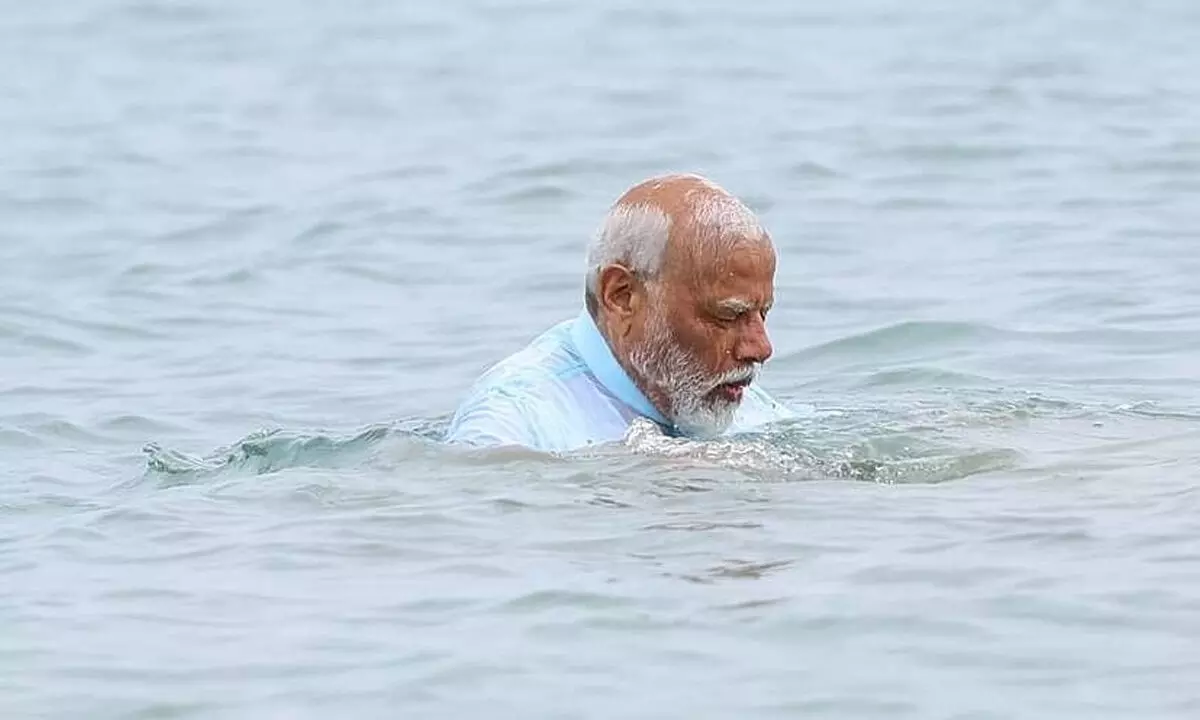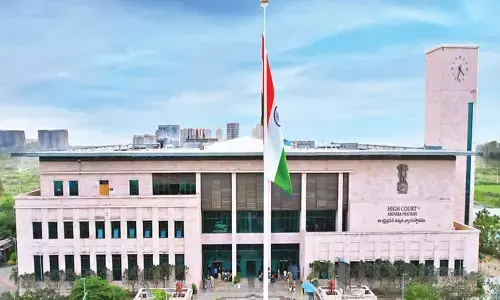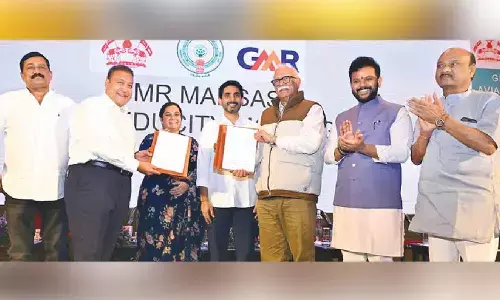PM Modi takes Holy Dip In Rameswaram

Ahead of Ram temple opening in Ayodhya tomorrow
Rameshwaram: Prime Minister Narendra Modi, who is currently on a three--day visit to Tamil Nadu, has been visiting temples in the holy city and he followed a 22-step purification process through 22 tirthas. Modi visited the Ramanathaswamy temple in Rameshwaram and offered prayers.
Modi is also currently observing an 11-day Anushthan till the 'Pran Pratishtha' of Sri Ram Lalla in Ayodhya on Monday, arrived in Tiruchirappalli on Saturday.
The 22-step purification process is mandatory to visit the Rameshwaram temple. To have a darshan, devotees have to purify themselves, for which they have to bathe 22 times.
In the Rameswaram temple, all the devotees are bathed with the water of 22 pilgrimages before having a darshan of the Jyotirlinga. Pilgrimage bath first begins with taking a dip in the Agni Tirtha. Everyone bathes in the sea at a short distance from this main temple which is called Agni Tirtha. After that enter the Rameshwaram temple. After bathing in Agni Tirtha, devotees have to now bathe with the water of 22 Tirthas. All these tirthas or kundas are inside the premises of the Rameswaram temple.
Earlier in the day, PM Modi was seen seeking blessings of an elephant, while clad in a white 'veshti' (dhoti) and an angawastram (shawl). At the Sri Ranganathaswamy temple, Modi was blessed with a 'Sadari' -- a crown symbolising blessings of Lord Vishnu.
On Sunday, Modi is scheduled to conduct Darshan and Pooja at the Kothandaraswamy Temple in Dhanushkodi. The Prime Minister is also expected to visit the Arichal Munai, the place where the Ram Setu is believed to have been constructed.
Continuing his routine over the last several days of visiting several temples and attending to the chanting of verses from the epic 'Ramayana' in various languages--Marathi, Malayalam and Telugu, PM Modi is scheduled to attend 'Sri Ramayana Parayana' at Sri Arulmigu Ramanathaswamy Temple on Sunday.
During the programme, eight different traditional Mandalis will recite the Sanskrit, Awadhi, Kashmiri, Gurumukhi, Assamese, Bengali, Maithili, and Gujarati Ramkathas (recounting the episode of Lord Ram's return to Ayodhya).
Ramayana-inspired temple circuit
In the span of the past two weeks, Prime Minister Narendra Modi has traversed from Maharashtra to Andhra Pradesh, Kerala, and Tamil Nadu. Commencing the 11-day ritual journey, PM Modi visited the Kalaram Temple in Panchavati, Maharashtra.
This locale, where Lord Ram, Sita, and Laxman spent a significant portion of their 14-year exile, holds historical and spiritual significance.
Veerbhadra Temple in AP
Continuing southward, PM Modi reached Lepakshi in Andhra Pradesh on January 16, visiting the Veerbhadra Temple. This location, linked to the Ramayana, plays a role in the epic's narrative involving the valiant Jatayu's fight against Ravan.
Ramaswami Temple
in Thrissur
Modi's next destination was the Sri Ramaswami Temple in Thriprayar, Kerala. Although details regarding its connection to the Ramayana are limited, the temple is known for its unique worship practice, 'vedi vazhipadu,' commemorating Hanuman's return from Lanka after meeting Sita.
Ranganathaswamy Temple in Trichy
In Trichy, Tamil Nadu, Modi visited the Sri Ranganathaswamy Temple. Associated with the Ramayana, the temple comes into the narrative after Lord Ram's triumph over Ravan.
Ramanathaswamy temple Rameswaram
Continuing his southward journey, PM Modi visited the Arulmigu Ramanathaswamy Temple in Rameswaram. This pilgrimage destination, one of the Char Dhams and featuring among the 12 Jyotirlingas, is dedicated to Sri Ramanathaswamy, a form of Lord Shiva.
Kothandaramaswamy temple in Dhanushkodi
Modi will conclude his temple visits with a visit to the Kothandaramaswamy temple in Dhanushkodi, near Rameswaram. This temple, dedicated to Sri Kothandarama Swamy, is associated with Lord Ram's breaking of the Ram Setu and the coronation of Vibhishan.
Ayodhya Finale on Jan 22
Mirroring the sequence of events in the Ramayana, PM Modi's journey is set to culminate in Ayodhya on January 22. This final leg involves the 'Pran Pratishtha' of Lord Ram's idol, symbolising the triumphant return of Lord Ram to Ayodhya after defeating Ravan in Lanka.








